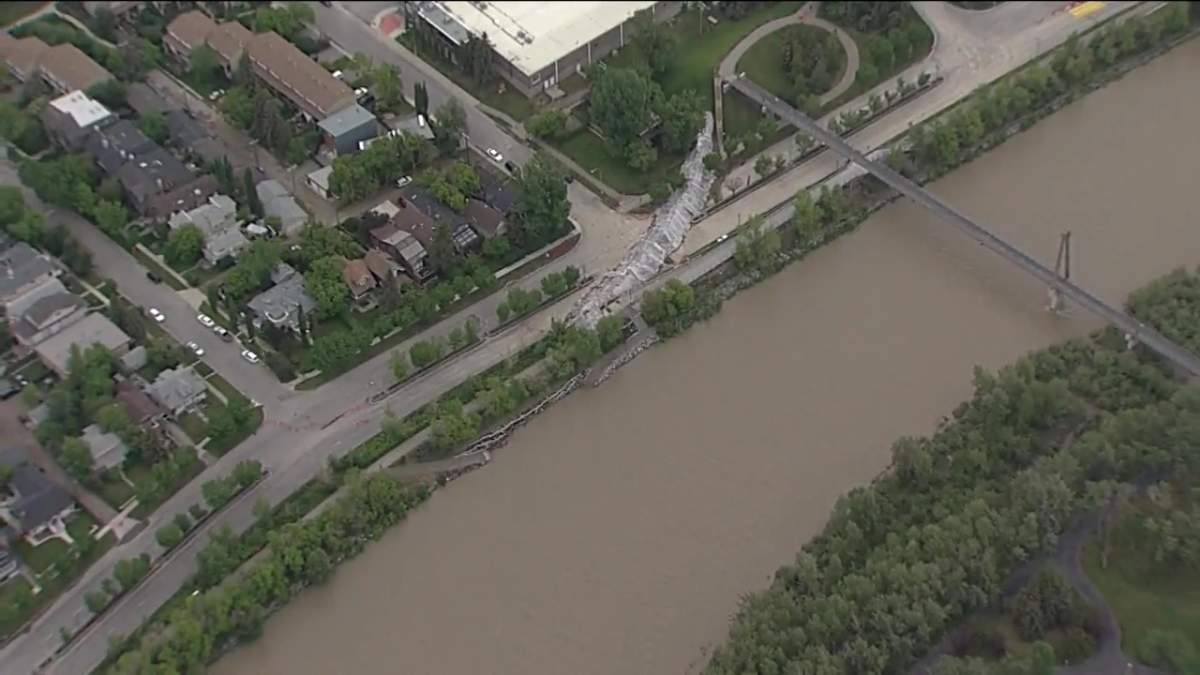The berm constructed on Memorial Drive during a significant rain warning cost roughly $115,000, Calgary Mayor Jyoti Gondek said, adding it helped save roughly $53 million-worth of property.

From Monday through Wednesday, between 100 and 150 millimetres of rain was expected, and 75 millimetres of rain came to the city.
Though the rain has likely stopped for the week, Gondek said the city is still monitoring a second weather event out in Kananaskis country and will keep the berm up until “Sunday or Monday.”
“That system is something water resources is keeping an eye on,” Gondek said at a news conference Thursday.
It took city crews about 18 hours to initially construct the berm and although it was precautionary to mitigate flood damage — it was also a hassle for drivers making their way around the city.
Gondek added crews will be creating a temporary break in the berm Thursday morning to allow for some traffic flow this week. The breaks are something she said can easily, and quickly be put back in place in case there was further flood mitigation to be needed.
Calgary Emergency Management Agency (CEMA) Chief Sue Henry added two lanes should be open at the very latest by Friday morning.

Want your weather on the go? Download the Global News Skytracker weather app.

Get daily National news
Cooler temperatures are a big reason why Calgary avoided higher river levels, according to Global Calgary’s chief meteorologist Tiffany Lizée. She explained that the cooler air kept moisture in the form of snow at higher elevations in the Rockies, which has led to a slower melt.
“If the mountains had heavy rain like what we had here in Calgary, then we likely would have seen higher river levels and severe flooding,” Lizée added.
Francois Bouchart with the city’s water resources department echoed what Lizée said at the news conference and added they’re now dealing with a watershed where the ground is saturated water and therefore could have the potential for a smaller flooding event.
“Parts of the Rockies, including areas at higher elevations around Banff, had upwards of 10 cm of snow this past week. As temperatures warm up, we’ll start to see that snow melt, as well as the snow pack beneath it. This will likely keep river levels high and flow rates fast,” Lizée explained.
Bouchart said the city has been in close contact with Environment and Climate Change Canada to monitor the system. Some of their models show the system moving east and north and bypassing Calgary altogether.
“We would love for that to be the outcome of this next system,” Bouchard said.
Bouchard said if the city were to get about 70 millimetres of rain over the next few days, it would result in an event that would see flows within the Bow River peaking at about 1,200 cubic meters per second — similar to what the city was projecting early on in the week.
“So I do want to stress that the risk is there and therefore we’re taking every precaution possible to ensure that we remain prepared and responsive to the events that we’re seeing,” he said, adding that most of the flood mitigation equipment is will stay put until the water levels dip down.

Chief Henry said at this time, the state of local emergency will continue to stay in place until they feel it’s safe to remove the berm. The water levels in the Bow and Elbow river remain high, she said.
“Instability over the next few days could result in thunderstorms which can bring heavy rainfall,” Lizée added.
“There’s also the potential for more rain to move through Alberta early next week, with the higher side of rainfall projections showing another 80-100 millimetres of rain possible for Kananaskis country over the next seven days.”
A silver lining for Calgarians is that most city parks have reopened with the exception of Rideau Park. The boating advisory also remains in effect for both the Bow and Elbow rivers, where the Calgary Fire Department will continue to monitor.
“For the safety of all emergency responders and all Calgarians, please stay away from the river banks and please stay off of the rivers at this time,” Henry cautioned. Due to various debris that could be under the water from the wind, it could create dangerous conditions without any warning.
CFD responded to a total of 1,008 calls since Monday and Henry said they’re still working to address some of those calls.









Comments